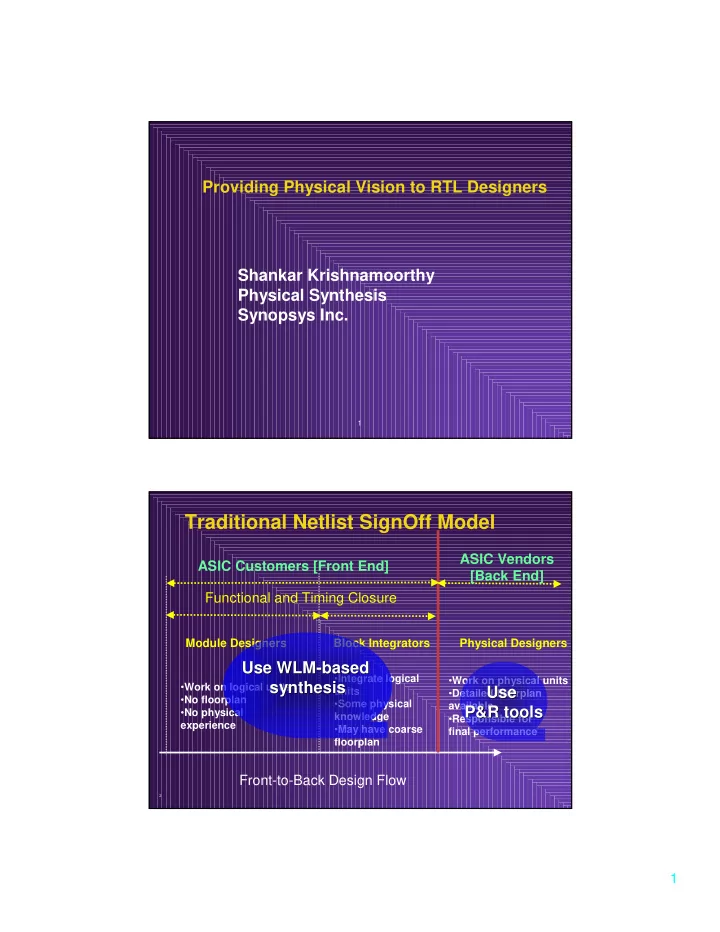

Providing Physical Vision to RTL Designers Shankar Krishnamoorthy Physical Synthesis Synopsys Inc. 1 Traditional Netlist SignOff Model ASIC Vendors ASIC Customers [Front End] [Back End] Functional and Timing Closure Module Designers Block Integrators Physical Designers Use WLM- Use WLM -based based • Integrate logical • Work on physical units synthesis synthesis • Work on logical units Use Use units • Detailed floorplan • No floorplan • Some physical available P&R tools P&R tools • No physical knowledge • Responsible for experience • May have coarse final performance floorplan Front-to-Back Design Flow 2 1
Timing Critical Designs: Performance Prediction is a Challenge Re fe re n c e F lo w (T ry # 3 ) Mo re o p tim istic W L M (tha n Try #2) u se d � � � WNS (ns) � � � � 0 RGXOH %ORFN � � � � E n d P o in ts 3 SignOff Models are evolving • Problems with traditional netlist SignOff model for timing-critical designs � Longer time to convergence � Missed performance targets • As a result, new SignOff models have emerged � RTL SignOff � Placement SignOff 4 2
New SignOff Models • RTL SignOff � RTL and constraints are handed off � ASIC vendor responsible for synthesis, P&R � ASIC customer responsible for RTL development/verification and design constraint specification • Placement SignOff � Netlist, placement, floorplan and constraints are handed off � High-level of predictability in performance � Requires P&R specialist in front-end team to drive floorplanning process 5 RTL SignOff Model • ASIC vendors can achieve certain level of performance � By using physical synthesis tools � But no flexibility to change RTL • This is an expensive and time consuming process • Design constraint specification is an iterative process � Needs knowledge about the design (which ASIC customers know best) � Needs accurate timing analysis that factors layout implications (which ASIC vendors know best) • Model is not scalable as implementation effort will shift to the vendor For timing-critical designs, intensive communication between ASIC customer and ASIC vendor 6 3
Placement SignOff Model • This model offers greater predictability compared to RTL/Netlist SignOff models • Offers ASIC customers “layout-sensitive” timing estimates resulting in: � RTL that is feasible for physical implementation � Design constraints that are realizable • However, this must not require ASIC customers to become layout experts Solution: Physical Prototype generation during RTL synthesis 7 Intuition for Physical Prototyping during RTL synthesis • Spatial locality maintained for modules/blocks during placement • Leverage this behavior to auto-generate physical prototypes for modules/blocks • Provide flow with very low cost of adoption for a RTL Design Placement Colored module designer by Logical Hierarchy � Has little or no knowledge of physical design 8 4
Performance Prediction with Physical Prototyping during RTL Synthesis R T L -P la c e d G a te s F lo w M in im a l P h ysica l C o n stra in t � � � WNS (ns) � � � � 0RGXOH %ORFN � � Allows designers to identify real critical � � E n d P o in ts nets during module compiles 9 Summary • RTL SignOff and Placement SignOff have been proposed as alternatives to traditional netlist SignOff model • RTL SignOff limits performance goals that can be achieved due to its restrictions • Placement SignOff improves predictability but needs to reduce the cost of adoption for front-end designers • Quality of SignOffs can be improved dramatically by introduction of RTL physical prototyping technology in logic synthesis 10 5
Recommend
More recommend